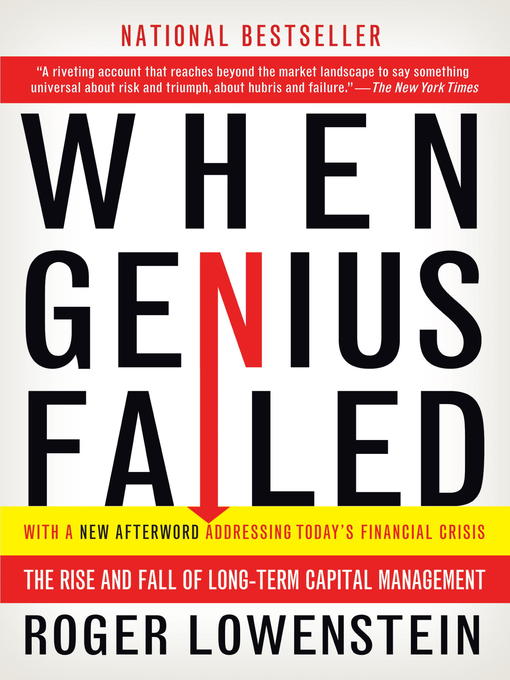
When Genius Failed
The Rise and Fall of Long-Term Capital Management
کتاب های مرتبط
- اطلاعات
- نقد و بررسی
- دیدگاه کاربران
نقد و بررسی

September 4, 2000
In late September 1998, the New York Federal Reserve Bank invited a number of major Wall Street investment banks to enter a consortium to fund the multibillion-dollar bailout of a troubled hedge fund. No sooner was the $3.6-billion plan announced than questions arose about why usually independent banks would band together to save a single privately held fund. The short answer is that the banks feared that the fund's collapse could destabilize the entire stock market. The long answer, which Lowenstein (Buffett) provides in undigested detail, may panic those who shudder at the thought of bouncing a $200 check. Long-Term Capital Management opened for business in February 1994 with $1.25 billion in funds. Armed with the cachet of its founders' stellar credentials (Robert Merton and Myron Scholes, 1997 Nobel Prize laureates in economics, were among the partners), it quickly parlayed expertise at reading computer models of financial markets and seemingly limitless access to financing into stunning results. By the end of 1995, it had tripled its equity capital and total assets had grown to $102 billion. Lowenstein argues that this kind of success served to enhance the fund's golden legend and sent the partners' self-confidence off the charts. As he itemizes the complex mix of investments and heavy borrowing that made 1994-1997 profitable years, Lowenstein also charts the subtle drift toward riskier (and ultimately disastrous) ventures as the fund's traditional profit centers dried up. What should have been a gripping story, however, has been poorly handled by Lowenstein, who obscures his narrative with masses of data and overwritten prose. Agent, Melanie Jackson. Author tour.

August 9, 2000
This is a marvelous, unauthorized chronicle of the rise, fall, and re-emergence of Long-Term Capital Management, a private hedge fund that in September 1998 benefited from a Federal Reserve-orchestrated $3.6 billion bailout. Based primarily on interviews with key players from the six banks that participated in the rescue of the firm, Lowenstein, who previously wrote Buffett: The Making of an American Capitalist, presents a well-crafted, easy-to-follow text. Readers will better appreciate the inner workings of the firm; the nuances of the individual partners; primary differences among investing in stocks, bonds, and derivatives; the fallacy of the efficient market hypothesis; the impact of computers on financial trading; and the importance of moderation. Recommended for both academic and public libraries. [Previewed in Prepub Alert, LJ 5/15/00.]--Norman B. Hutcherson, Kern Cty. Lib., Bakersfield, CA
Copyright 2000 Library Journal, LLC Used with permission.

July 1, 2000
Lowenstein, a financial journalist and author, weaves the remarkable tale of the debacle of Long-Term Capital Management (LTCM), which was worth $4.7 billion at the start of 1998, but, just nine months later, was on the verge of bankruptcy. LTCM was rescued by major financial institutions, led by the Federal Reserve, although it had not actually been funded by the Reserve. The story begins with leader John Meriwether, who in 1977 formed the Arbitrage Group at Salomon Brothers with a band of academics who developed computer models to deconstruct and ultimately minimize risk. Subsequently, these academics became LTCM partners, along with two Nobel laureates, and, blinded by arrogance, they were convinced that the markets would never veer from their predictions. The author concludes that the demise of LTCM stems from a major managerial weakness: failing to oversee the traders. However, memories are short on Wall Street, and in late 1999, Meriwether and other LTCM partners formed JWM Partners with $250 million, much of it obtained from former investors. Lowenstein claims this book is an unauthorized history of LTCM, and it has the ring of historical fiction because thoughts and attitudes ascribed to players in the story call into question its accuracy--the narrative is based on interviews with only two partners, an internal financial report, and anonymous sources. Still, the disaster wrought by LTCM's activities is a matter of record, and the business and financial community, as well as general readers with a keen interest in that world, will enthusiastically receive this very engrossing, smoothly written book. Expect demand. ((Reviewed July 2000))(Reprinted with permission of Booklist, copyright 2000, American Library Association.)

























دیدگاه کاربران